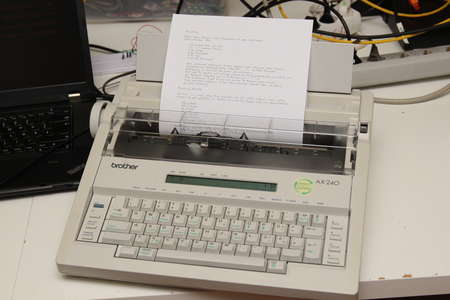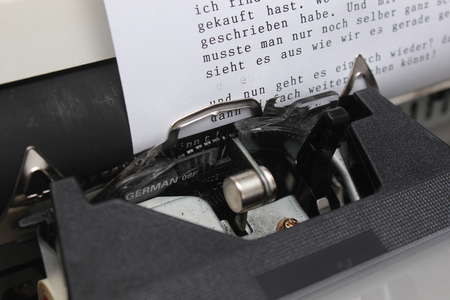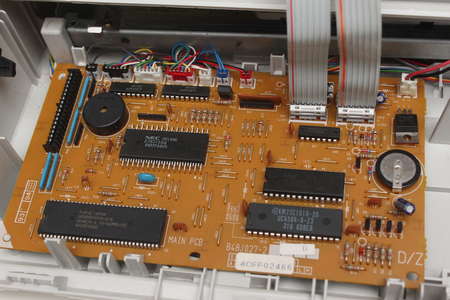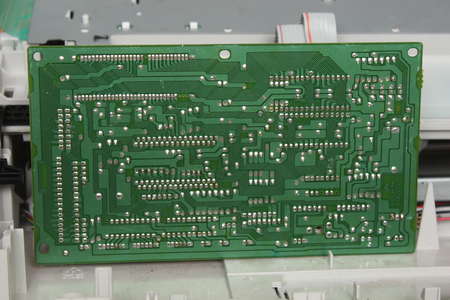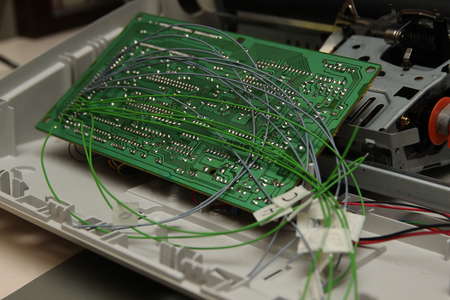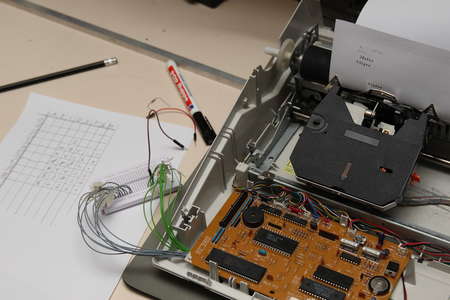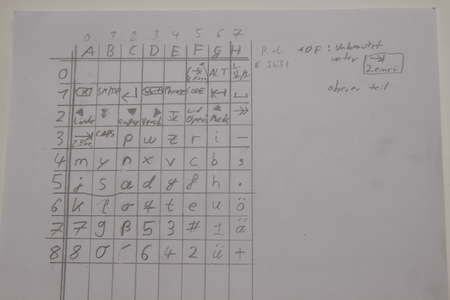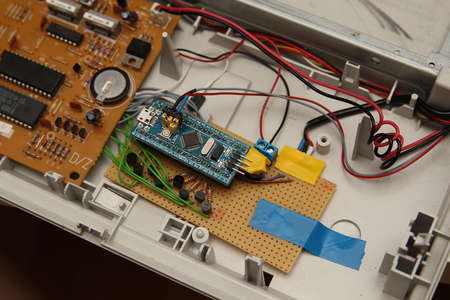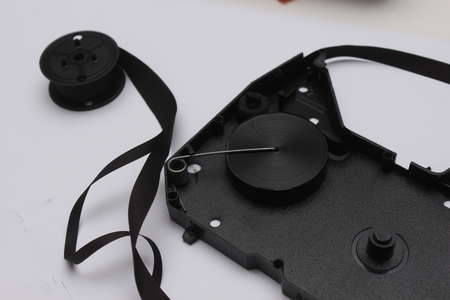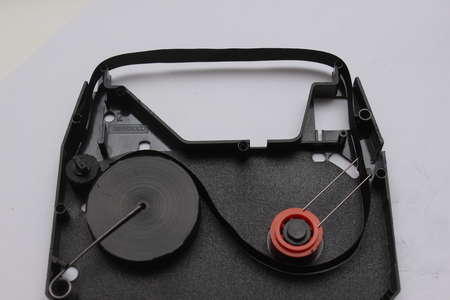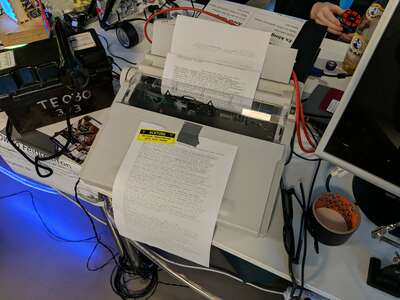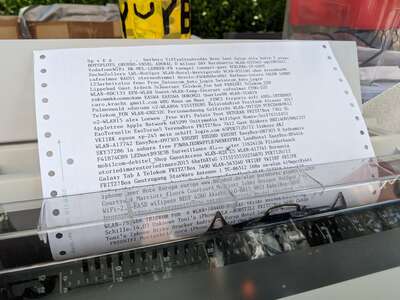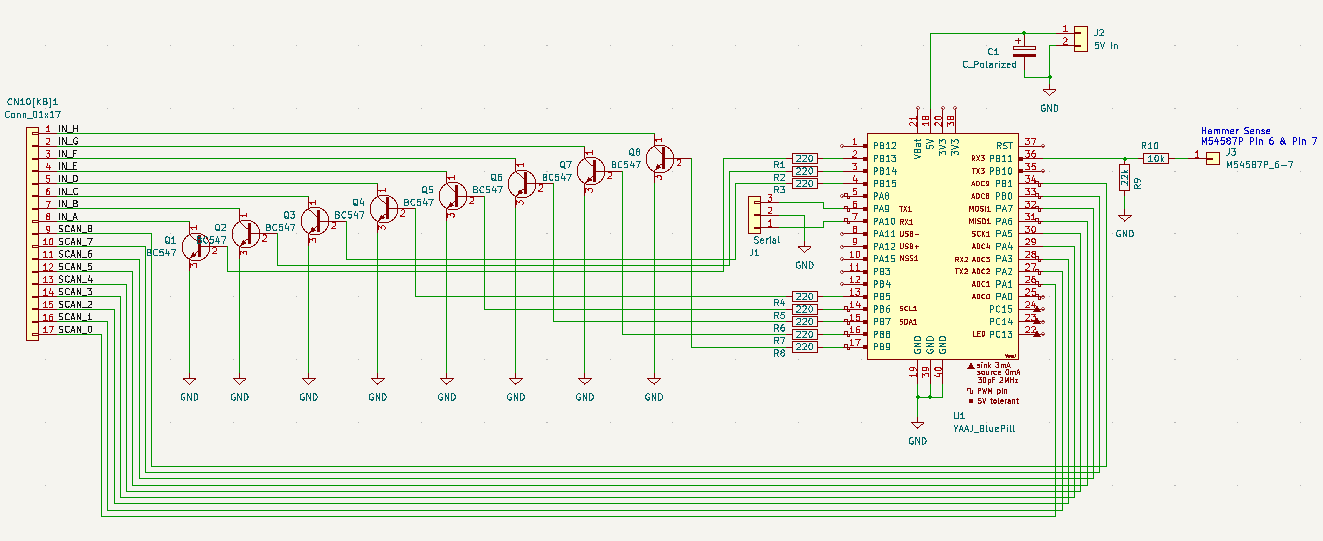Elektrische Schreibmaschine
Januar 2018
Generell bin ich fastziniert von Geräten, die eine komplex scheinende Aufgabe automatisch erledigen. Dazu zählen auch die Fernschreiber (engl. Teletype), welche wie eine handelsübliche Schreibmaschine Text auf Papier schreiben, jedoch von selbst.
Leider sind diese Maschinen schwer zu bekommen und meist auch eher teuer, zumindest um ein bisschen damit rumzuspielen.
Generell bin ich fastziniert von Geräten, die eine komplex scheinende Aufgabe automatisch erledigen. Dazu zählen auch die Fernschreiber (engl. Teletype), welche wie eine handelsübliche Schreibmaschine Text auf Papier schreiben, jedoch von selbst. Leider sind diese Maschinen schwer zu bekommen und meist auch eher teuer, zumindest um ein bisschen damit rumzuspielen.Elektrische Schreibmaschinen gibt es schon eine ganze Weile. Also kann es ja nicht so schwer sein den Microcontroller darin anzusprechen und die Maschine von aussen zu bespielen? Ohne mich zu lange in Details zu verlieren hab ich bei Ebay Kleinanzeigen eine Brother AX-240 für 30€ in wunderbarem Zustand bekommen.
Mit dabei waren zwei Farbbänder. Nachdem ich mich mit den Funktionen etwas auseinandergesetzt hatte ging es an das Innere.
Dort zu finden war eine Platine mit mehreren IC’s. Leider waren bei dem Haupt-Microcontroller die Pins, die laut Datenblatt als Serielle Schnittstelle beschaltet werden können bereits mit IO’s belegt und daher auf diese fest Konfiguriert.
Nach etwas Überlegung kam ich zu dem Entschluss, dass es wohl am Einfachsten wäre die Tastatur zu simulieren.
Die Tastatur ist als 9x8 Matrix aufgebaut; ein Teil der Tasten wird mehrfach pro Sekunde durchgescannt (Leitungen auf Masse gezogen). Sobald eine Taste gedrückt wird ist die entsprechende Zeile (0-8) mit der zu dem Zeitpunkt geprüften Spalte (A-H) verbunden. Der Controller weiß daher durch den verbunden Pin und den Zeitpunkt welche Taste gedrückt ist.
Genau dies wollte ich durch einen separaten Controller simulieren. Dieser misst die Zustände der Scanlines und schaltet mit einem BC547B NPN Transistor zu den eintsprechenden Zeitpunkten den Ausgang für die Spalte.
Durch Zurückverfolgen jeder Taste auf der Leiterfolie kam ich zu folgendem Aufbau der Matrix. Eine Taste lasse ich mindestens drei Zyklen lang gedrückt, da sonst eine vermutlich interne softwareseitige Entprellung den Tastendruck unterdrückt.
Werden Tasten schneller gedrückt, als das “Dasywheel” der Schreibmaschine arbeiten kann werden Zeichen in einen internen Puffer eingereiht. Durch die Verwendung eines STM32F103C8T6 (“Bluepill”) und Serieller Datenübertragung mit nur 9600 Baud ist dieser Puffer jedoch in Sekundenbruchteilen voll. Daher war es nötig zu erkennen, wann der Hammer der Schreibmaschinenmechanik ein Zeichen auf das Papier gebracht hat. Ein Darlighton Array wird hier dazu genutzt den Zugmagnet für den Hammer zu bestromen. Auf der Eingangsseite des M54587P Darlighton Array IC’s konnte ich an Pin 6 und 7 ein Signal messen, wenn der Hammer ausgelöst wird. Schnell noch ein Kabel von dort an einen interruptfähigen Eingang des neuen Microcontrollers und nun kann er mit den simulierten Tastendrücken auf die Schreibmaschine warten. Der Arduinocode für den STM mit Dokumentation in den Kommentaren ist unten zu finden.
Mit der nun durch einen PC steuerbaren elektrischen Schreibmaschine werde ich Spielereien umsetzen, wie z.B. ASCII-Art oder das ausgeben eines IRC Kanals. Das Farbband des Brother AX-240 ist leider dazu vorgesehen ausgetauscht zu werden, sobald die 150m komplett durchgelaufen sind. Um das Farbband endlos benutzen zu können musste ich das Nylonband durch eines aus Stoff ausstauschen. Dazu kaufte ich ein Ersatzband für eine beliebige Schreibmaschine, welches ich auf 8 mm Breite schneiden und zu einem Endlosband zusammenkleben konnte.
Da sich nun links das Band nicht mehr aufwickelt musste dort eine Rolle hin, sodass das Farbband dort eingepresst wird und bewegt werden kann.
Nach einiger Zeit war das Band jedoch auf diesem Stück verbraucht. Stempelkissentinte soll allerdings dazu taugen Farbbänder wieder aufzufüllen.
Das klappte hier auch einigermaßen gut, sorgt zudem auch für einen Retrolook der geschriebenen Buchstaben.
Mit einem FTDI Serial - USB Konverter kann die Schreibmaschine nun einfach an einen Rechner angeschlossen werden. Gesendeter Text wird direkt bestmöglich umgesetzt. Ein paar Zeichen sind in dem Zeichenrad der Schreibmaschine jedoch nicht vorhanden, wie z.B. das “@”.
Das Gerät hab ich auf ein paar Veranstaltungen mitgenommen und mit einem esp8266 verbunden, der als probe request sniffer funktioniert. Sobald ein Smartphone in der Nähe nach bekannten Access Points fragt wird die SSID aufs Papier geschrieben.
Gerne möchte ich an dieser Stelle noch den Schaltplan zu der Verbindung von BluePill zum PCB der Schreibmaschine teilen. Die Versorgungsspannung wird an einem Kondensator abgegriffen. Für die Erkennung, wann der Hammer auslöst, ist ein Kabel (weiß) zu Pin 6 und 7 des M54587P Darlighton Array IC notwendig. Verbindungen zur Tastaturmatrix werden ueber einen angelötete Buchsenleiste links im Bild herstellt.
- Code and Schematics: git.ctdo.de/interfisch/brotherax_teletype
- ACSII-Art Converter: asciiart_20180626.zip
